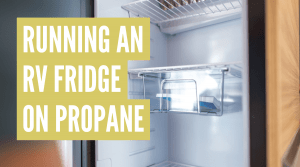Camper FAQs is reader-supported. Buying through links on our site may earn us an affiliate commission. As an Amazon Associate I earn from qualifying purchases.
Hooking up an external propane tank to your RV is as easy as installing a special adapter between your RV’s permanent propane tank and the propane regulator. Here’s how in 3 simple steps!
What You’ll Need:
- Camco RV External Propane Tank Adapter (sometimes referred to as an extended-stay propane adapter or extend-a-stay adapter)
- Portable propane tank
- Optional: Additional propane-powered appliance (gas grill, heater, etc.)
Important: If you don’t feel comfortable performing this step-by-step process, take your recreational vehicle to a certified RV technician. They should be able to install the connector fairly quickly and affordably.
Step 1: Disconnect Propane Regulator From Your Permanent Propane Tank

First, you’ll need to locate your permanent ASME propane tank on your motorhome. It’s typically accessible via a door on the outside of the rig. You should have a propane regulator connected to your propane tank at this point.
Ensure the gas is turned off, and disconnect the regulator from the propane tank. You may have to remove the cover from your regulator if you have one.
Step 2: Install the Camco RV External Propane Tank Adapter

The external propane tank adapter will permanently connect between your RVs permanent propane tank and the propane regulator.
I highly recommend the Camco RV External Propane Tank Adapter kit! It allows for super easy hookup and includes all hoses and fittings. Plus, in addition to hooking up external propane tanks, you can also hook up another gas-powered appliance!

Camco RV External Propane Tank Adapter
Price:Clicking this link to make a purchase may earn us a commission at no additional cost to you.
First, we need to attach Port A directly to the permanent propane tank by simply screwing it in counterclockwise.
Tip: You want Port C facing up and Port D facing out towards you.
Now, simply attach the propane regulator to Port B of your external propane tank adapter. Again screw it in counterclockwise.
Important: Make sure the vent on the regulator is facing down after you attach it.
Next, make sure there are no leaks by using a soapy water mixture and spraying it all over your connections. If you find any leaks, tighten the connection or call an RV service technician for help.
Once you are certain there are no fuel leaks, reinstall the cover over your regulator if you have one.
Step 3: Connect Your External Propane Tank

Finally, you can connect your external propane tank or bottle by attaching the 1/4″ inverted flare end of the included 5 ft. hose to Port D and attaching the P.O.L. end to the external propane tank.
You don’t need to worry about attaching another propane regulator to your external tank since the gas from the external tank will simply flow through the regulator attached to your permanent tank.
If you have difficulty starting your propane-powered appliances, you may have to purge your RV propane lines.
Optional Step 4: Attach an External Gas Appliance
Camco RV External Propane Tank Adapter kits feature a 4-way brass Tee connection. And one of these connections will allow you to hook up an external gas-powered appliance, like a portable BBQ grill or heater.
To do this, simply connect one end of the included 12′ foot hose to Port C and the other end of the line to your gas-powered appliance.
Important: Be sure you have a propane regulator between the 12 ft. hose and the propane-powered appliance. The gas flowing to the external appliance does not flow through the psi regulator attached to your permanent LP tank on your camper.







Write a comment